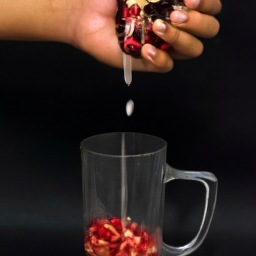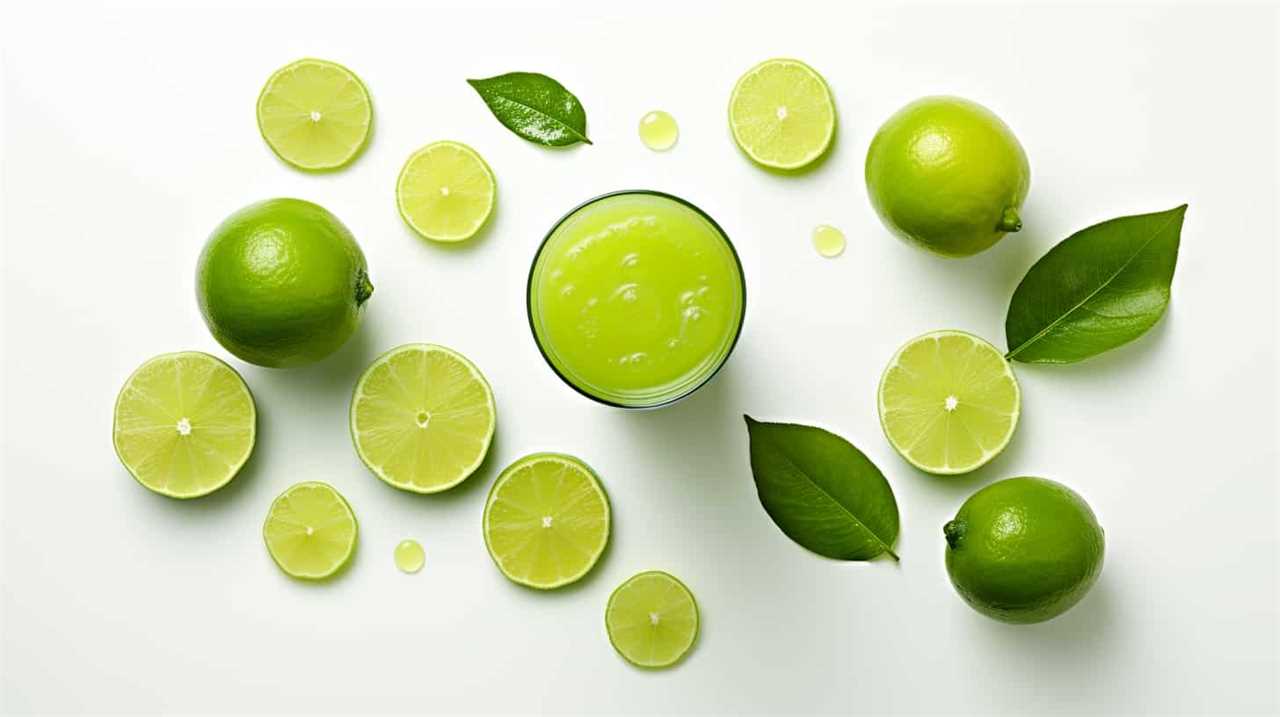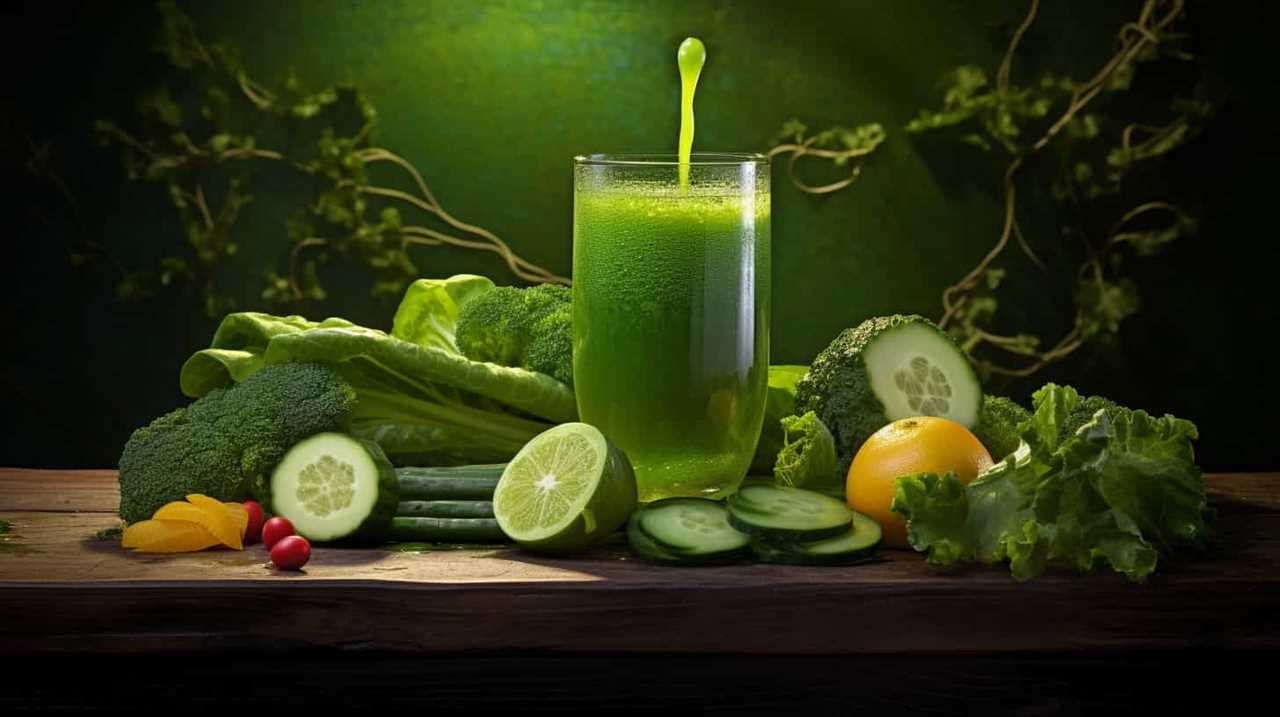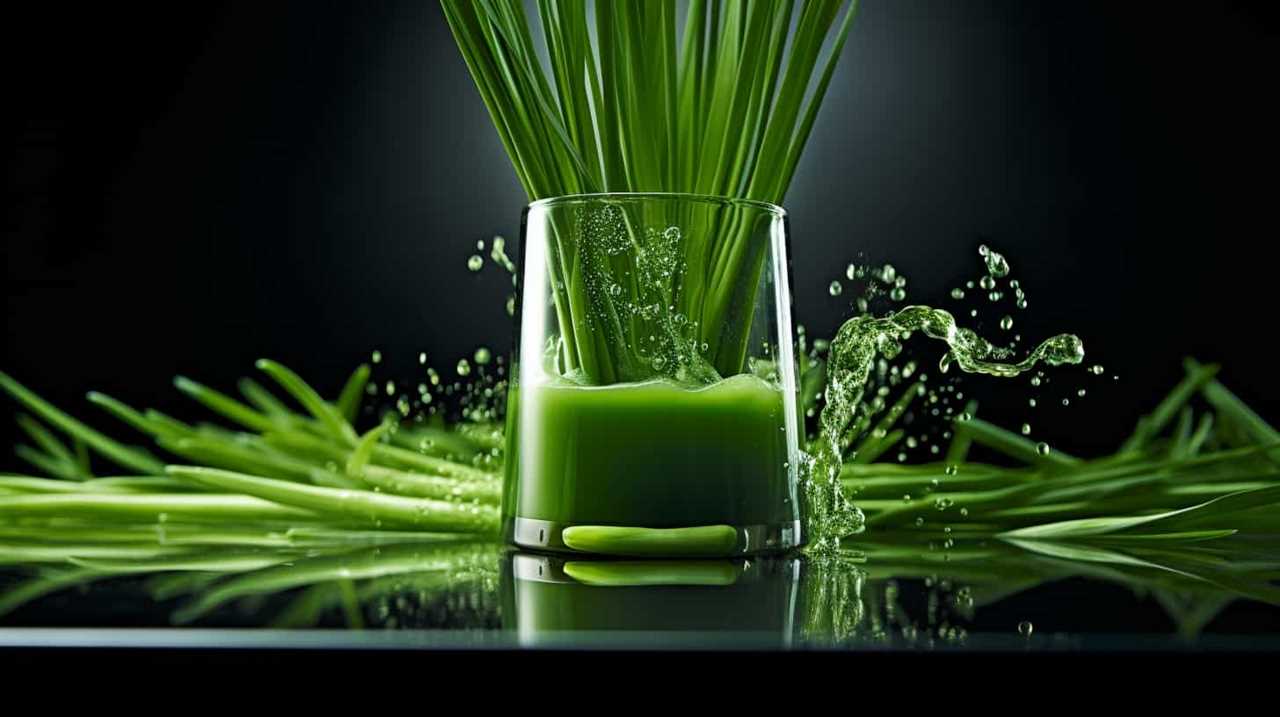Juice Tips and Tricks
How To Juice A Pomegranate In A Juicer

I love pomegranates. They provide a wonderful mix of sweet and tart flavors, plus they are packed with antioxidants. Enjoying them can be a great experience! However, there are times when I don’t feel like dealing with the seeds. That’s when I opt for juicing.
Juicing a pomegranate is a great way to get all the health benefits without having to do all the work of extracting the seeds. In this article, I’m going to show you how to juice a pomegranate in a juicer.
First, we’ll talk about selecting the right pomegranate. You want to look for one that is heavy for its size, with a deep red color and a glossy skin.
Then, we’ll talk about choosing the right juicer. There are several types of juicers on the market, but not all of them are great for pomegranates. We’ll discuss the pros and cons of different types of juicers, and help you choose the one that’s right for you.
Finally, we’ll walk you through the steps of preparing the juicer, cutting the pomegranate, and juicing the fruit. We’ll also give you tips for using a strainer, storing the juice, and cleaning up afterwards.
By the time you’re done reading this article, you’ll be a pro at juicing pomegranates!
Key Takeaways
- Choosing an organic pomegranate is preferred
- Masticating and hydraulic press juicers extract more juice and nutrients
- Removing seeds is an important step in making smooth and enjoyable pomegranate juice
- Effective cleanup ensures freshly squeezed juice for years to come
Selecting the Right Pomegranate
Before you start juicing, make sure you’ve chosen the perfect pomegranate by feeling for firmness and looking for vibrant color. A ripe pomegranate should feel heavy for its size and have a slightly soft spot on one end. If it feels too soft or has bruises or cracks, it may be overripe or damaged.
On the other hand, an unripe pomegranate will feel hard and may have a pale or greenish color. It’s best to avoid unripe pomegranates as they won’t have as much juice or flavor. When selecting a pomegranate, you may also want to consider choosing an organic variety over a conventional one.
Pomegranate skin is thin and edible, making it easy for chemicals and pesticides to penetrate the fruit. By choosing organic, you can avoid consuming any harmful substances and support sustainable farming practices. With a perfectly ripe and preferably organic pomegranate, you’re ready to move on to choosing the right juicer for the job.
Choosing the Right Juicer
To ensure optimal results, you’ll want to select the appropriate equipment for the task at hand. When it comes to juicing a pomegranate, you have a few options for juicers. The most common types of juicers are centrifugal, masticating, and hydraulic press juicers.
Centrifugal juicers are the most affordable and widely available, but they may not be the best option for juicing pomegranates. These juicers use a high-speed blade to extract juice quickly, but they may not be able to effectively extract all of the juice from the pomegranate seeds. Masticating juicers are a bit more expensive, but they use a slower process that can extract more juice from the seeds. Hydraulic press juicers are the most expensive, but they use a gentle process that can extract the most juice and nutrients from the pomegranate. Whichever type of juicer you choose, be sure to follow the manufacturer’s instructions and perform regular maintenance to keep your juicer in good working order.
In addition to choosing the right type of juicer, it’s important to keep your juicer well-maintained to ensure optimal performance. Regular cleaning and maintenance can help prevent clogs and damage to your juicer. Be sure to clean your juicer after each use, and take apart any removable parts to clean them thoroughly. In addition, be sure to check your juicer for any signs of wear or damage, and replace any worn or damaged parts as needed. By choosing the right type of juicer and performing regular maintenance, you can ensure that your pomegranate juice is delicious and nutritious. Now, let’s move on to preparing the juicer for use.
Preparing the Juicer
Get ready to make the most out of your chosen equipment by following these essential steps for preparing your machine. Before starting to juice a pomegranate, it’s important to ensure that your juicer is clean and in good working condition. Cleaning instructions are usually provided in the user manual, so make sure to read them carefully before starting.
If your juicer has removable parts, take them apart and wash them thoroughly with warm soapy water. Rinse them well and dry them with a clean cloth. If there are any stains or mineral deposits, you can soak them in vinegar or lemon juice for a few minutes before washing them off.
Next, assemble the juicer according to the manufacturer’s instructions. Make sure all the parts fit snugly and that there are no loose screws or parts. If you encounter any problems or difficulties, consult the troubleshooting tips in the manual or online forums.
Once you are confident that your juicer is ready to go, it’s time to move on to the next step: cutting the pomegranate. Now that your juicer is prepped and ready to go, it’s time to move on to the next step: cutting the pomegranate.
Cutting the Pomegranate
Now that you’re ready to dive into the juicy goodness, imagine holding a pomegranate in your hand like a precious gemstone, its ruby-red jewels shining in the light. Before we start cutting the pomegranate, we need to choose the right knife. I recommend using a sharp paring knife or a chef’s knife. Make sure the knife is sturdy enough to cut through the tough skin of the pomegranate without slipping.
Once you have your knife, the first step is to remove the crown. The crown is the protruding stem at the top of the pomegranate. Using your knife, make a shallow cut around the crown, and gently lift it off. Be careful not to cut too deep, as this will damage the seeds inside. After removing the crown, you’re ready to cut the pomegranate into sections.
Now that we have removed the crown and cut the pomegranate into sections, we are ready to start juicing.
Juicing the Pomegranate
After cutting the pomegranate into sections, gently press each section with your fingers to release the delicious seeds. Place each section into the juicer with the seeds facing down. Turn on the juicer and let it do its magic!
The juicer will extract the juice from the seeds, leaving you with a refreshing and healthy drink. Not only is pomegranate juice delicious, it also has numerous health benefits. Pomegranate juice is a great source of antioxidants, which can help protect your body against free radicals and reduce inflammation.
It may also lower your risk of heart disease and improve your digestive health. You can enjoy pomegranate juice on its own or mix it with other fruits and vegetables to create a tasty and nutritious juice blend. Try adding some apple and ginger for a sweet and spicy kick, or mix with spinach and cucumber for a refreshing green juice.
To handle the seeds, simply strain the juice through a fine mesh sieve or cheesecloth to separate the seeds from the juice. You can save the seeds for snacking or to use as a garnish for salads and other dishes. Now that you know how to juice a pomegranate, the possibilities are endless!
Handling the Seeds
Once the pomegranate has been juiced, handling the seeds is a breeze and they can be saved for snacking or used as a garnish for salads and other dishes. To remove the pulp from the seeds, I like to gently rub them with my fingers under running water. This helps to loosen any remaining pulp and allows it to rinse away easily, minimizing mess and making the seeds easier to handle.
Handling the seeds can be an enjoyable experience, especially when you consider the many benefits of pomegranate. Not only are they rich in antioxidants, but they’re also a good source of vitamin C and fiber. Plus, they add a delicious crunch to any dish or snack.
Once the seeds are cleaned, they can be used in a variety of ways, from topping off your favorite yogurt to adding a pop of color to your favorite salad.
Next up, we’ll talk about using a strainer to ensure your pomegranate juice is smooth and pulp-free.
Using a Strainer
Now that I’ve juiced the pomegranate in my juicer, it’s time to filter the juice and remove any remaining seeds. Using a strainer is the best way to achieve this.
First, I’ll pour the freshly squeezed juice through the strainer to catch any large pieces of seeds or pulp.
Filtering the Juice
To get a smooth and pulp-free juice, simply pour the pomegranate seeds and juice into a fine mesh strainer placed over a bowl. Use a spoon or rubber spatula to press the juice through the strainer while leaving the seeds and pulp behind.
This method is perfect for those who want to use the juice in pomegranate juice recipes that require a clear liquid. If you find that there is still some pulp in the juice, you can use a cheesecloth or coffee filter to filter the juice again.
Simply pour the juice through the cheesecloth or coffee filter and into a clean container. This will ensure that your juice is completely smooth and free of any remaining seeds or pulp. Now that you’ve filtered the juice, it’s time to move on to the next step of removing any remaining seeds.
Removing Any Remaining Seeds
You can easily get rid of any remaining seeds by using a spoon or your fingers to skim the surface of the juice and remove them. Seed removal techniques are important to ensure a smooth and enjoyable drinking experience. Pomegranate seeds are rich in antioxidants and other beneficial nutrients, so it’s worth taking the extra time to remove any lingering seeds from the juice.
Here are three simple steps to remove any remaining seeds from your pomegranate juice:
- Skim the surface of the juice with a spoon to remove any visible seeds.
- Use your fingers to gently feel for any hidden seeds and remove them.
- Pour the juice through a fine mesh strainer to catch any small seeds that may have been missed.
By taking the time to remove any remaining seeds, you’ll be left with a smooth and delicious juice that’s packed with nutrients. Now that your juice is seed-free, it’s time to move on to the next step: storing the juice.
Storing the Juice
When storing your freshly squeezed pomegranate juice, remember to keep it in an airtight container to preserve its vibrant color and tangy flavor, like a precious gem waiting to be savored.
While pomegranate juice can be stored in the refrigerator for up to five days, if you want to preserve its freshness for a longer period, consider freezing it. Pour the juice into ice cube trays and place them in the freezer. Once frozen, transfer the cubes to a ziplock bag and store in the freezer for up to six months. This method not only preserves the juice’s flavor and nutritional value but also gives you the flexibility to use it as needed.
When it’s time to enjoy the juice, you can thaw it in the fridge or let it sit at room temperature for a few hours. Alternatively, you can add the frozen cubes directly to smoothies, cocktails, or other recipes without thawing.
Now that you know how to store your freshly squeezed pomegranate juice, let’s move on to the next step of savoring its delicious flavor.
Enjoying the Juice
Indulge in the deliciousness of this vibrant and tangy elixir, savoring each sip as it awakens your taste buds. Pomegranate juice is not only delicious, but it also boasts an impressive list of health benefits.
It’s packed with antioxidants, which can help protect your body against harmful free radicals. Additionally, it contains a high amount of vitamin C, which supports a healthy immune system and can even help promote collagen production for healthy skin.
If you’re looking for recipe ideas, try mixing pomegranate juice with sparkling water for a refreshing mocktail or adding it to smoothies for an extra boost of flavor and nutrition. You can even use it as a base for salad dressings or marinades.
Whatever way you choose to enjoy it, you can feel good knowing that you’re nourishing your body with a tasty and nutritious beverage.
Now, let’s move onto the next step of the process: cleaning up.
Cleaning Up
As I finish enjoying the vibrant pomegranate juice, I know that the cleanup process is just as important as the juicing process. Effective cleanup not only prevents any mess from lingering but also helps to maintain the longevity of my juicer.
To ensure that I’m cleaning up efficiently, I follow these steps:
-
First, I unplug my juicer and disassemble it. This involves removing any removable parts, such as the pulp catcher and strainer, and placing them in a sink filled with warm, soapy water.
-
Next, I use a soft brush or sponge to clean the juicer’s exterior and interior surfaces, making sure to remove any remaining pulp or seeds. I avoid using abrasive materials or harsh chemicals as they can damage the juicer.
-
To prevent any mess from occurring in the first place, I lay down a few sheets of newspaper or a towel underneath the juicer to catch any drips or spills.
By following these simple steps, I can ensure that my juicer is clean and ready to use for the next time I want to make some delicious pomegranate juice. Effective cleanup not only prevents any mess from lingering but also helps to maintain the longevity of my juicer, ensuring that I can enjoy freshly squeezed juice for years to come.
Frequently Asked Questions
Can I juice a pomegranate without a juicer?
Yes, there are alternative techniques for juicing a pomegranate without a juicer. Some juicing methods include using a blender or food processor to blend the seeds, or manually squeezing the fruit with a citrus juicer or by hand.
How do I know if a pomegranate is ripe enough to juice?
When I’m looking to juice a pomegranate, I always go for the biggest, brightest, and heaviest ones I can find. I check the color – it should be a deep red or dark pink – and use proper harvesting techniques to gently remove the fruit without damaging it.
Can I juice the pomegranate seeds along with the arils?
Juicing pomegranate seeds along with the arils has its pros and cons. While it’s faster and more efficient, it may produce a more bitter taste. Separating the arils first can result in a sweeter juice, but takes more time.
How long does pomegranate juice stay fresh in the refrigerator?
Did you know that pomegranate juice has a longer shelf life than most fruit juices? It can last up to 5 days in the fridge if stored properly. To maximize freshness, keep it in a tightly sealed container and consume within that timeframe. Remember to always check for any signs of spoilage before drinking.
Can I freeze pomegranate juice for later use?
Yes, I freeze pomegranate juice for later use. It retains its nutritional benefits and taste for up to 6 months. I use it for smoothies, cocktails, and salad dressings. Try recipes using frozen pomegranate juice for a healthy boost.
Conclusion
In conclusion, juicing a pomegranate in a juicer can be a rewarding experience. It requires patience, care, and attention to detail, but the end result is a glass of delicious, nutrient-rich juice that is sure to impress.
As I sip my own freshly squeezed pomegranate juice, I’m reminded of the symbolism of this fruit. With its vibrant red seeds, the pomegranate represents life, fertility, and abundance. Drinking its juice is not only good for our health, but it also connects us to the natural world and the cycle of growth and renewal.
So next time you find yourself with a pomegranate and a juicer, take the time to appreciate the process and the symbolism behind it. Choose a ripe, plump fruit and a sturdy, reliable juicer. Prepare your workspace and take the time to cut the fruit properly.
Juice it slowly and carefully, using a strainer to remove any unwanted pulp or seeds. Store the juice in an airtight container and enjoy it throughout the day. And when you’re done, take a moment to clean up and reflect on the experience. As you sip, appreciate the freshness and effort it took to create something so simple yet nourishing. Next time, perhaps try to juice a grapefruit by hand, feeling the texture of the fruit and the natural rhythm of the process. It’s a mindful act that connects you with the food you consume, reminding you to savor each drop.
Juicing a pomegranate is not just about making a drink, but about connecting with nature and nourishing our bodies and souls.
Susannah expertise lies in researching and compiling evidence-based content on juicing, nutrition, and overall health. She is committed to ensuring that The Juicery World offers accurate, up-to-date, and trustworthy information to empower readers to take control of their health. Susannah’s goal is to inspire individuals to embrace juicing as a way to nourish their bodies and live their best lives.
Juice Tips and Tricks
How to Make Aloe Vera Juice Taste Better

Tired of the strong flavor of aloe vera juice? No problem, we’ve got the answer for you.
In this article, we’ll share some tips and tricks to make your aloe vera juice taste better. We have tried and tested various methods to enhance the flavor without compromising the health benefits.
From choosing the right juice to adding natural sweeteners and infusing with fruits and herbs, we’ve got all the information you need to transform your aloe vera juice into a delightful and refreshing beverage.
Let’s dive in!

Key Takeaways
- Choose a reputable brand of aloe vera juice that prioritizes quality and uses organic, pure aloe vera.
- Avoid brands that contain added sugars or artificial ingredients.
- Use natural sweeteners like honey, agave syrup, or stevia to enhance the taste of aloe vera juice.
- Experiment with adding fruits, herbs, and other juices to create unique flavor combinations and enhance the health benefits of aloe vera juice.
Choosing the Right Aloe Vera Juice
We can enhance our experience with aloe vera juice by selecting the right brand and type for our preferences. When it comes to finding a reputable brand, it’s important to do some research and read reviews from other consumers. Look for brands that prioritize quality and use organic, pure aloe vera without any added sugars or artificial ingredients. Understanding the health benefits of aloe vera juice is also crucial in making the right choice. Aloe vera is known for its soothing properties, aiding digestion, promoting skin health, and boosting the immune system. By choosing a high-quality brand, we can ensure that we’re getting the maximum benefits from our aloe vera juice.
Now that we know how to choose the right brand, let’s move on to the next step of adding natural sweeteners.
Adding Natural Sweeteners
To enhance the flavor of our aloe vera juice, we can add natural sweeteners such as honey or agave syrup. Using alternative sweeteners not only adds sweetness but also brings unique flavors to the juice. Here are some options to consider:
- Stevia: A natural sweetener derived from the Stevia plant, it’s a zero-calorie alternative to sugar.
- Maple Syrup: This natural sweetener adds a rich and earthy flavor to the aloe vera juice.
- Dates: Pureed dates can be used to sweeten the juice while also providing essential nutrients like fiber.
In addition to using alternative sweeteners, we can enhance the flavor of aloe vera juice by adding spices and extracts. Cinnamon, ginger, or vanilla extract can add warmth and depth to the taste. By experimenting with different combinations of these natural sweeteners, spices, and extracts, we can create a flavor profile that suits our preferences.

Now, let’s move on to the next section and learn how to infuse aloe vera juice with fruits and herbs to further enhance its taste.
Infusing With Fruits and Herbs
As we explore ways to make our aloe vera juice taste better, one option to consider is infusing it with fruits and herbs. Creating unique aloe vera blends by adding fruits and herbs not only enhances the flavor but also adds a touch of freshness and complexity to the juice. For example, combining aloe vera juice with lemon, mint, or berries can create a refreshing drink that’s both delicious and packed with additional nutrients. It’s similar to the ease of making lemonade with bottled juice—quick, convenient, and customizable to suit your preferences. By experimenting with different fruit and herb combinations, you can elevate your aloe vera juice experience while still reaping its health benefits.
Fruits like strawberries, pineapple, or citrus can add a burst of sweetness, while herbs like mint, basil, or ginger can provide a subtle yet refreshing twist. Exploring the benefits of herbal infusions can also be beneficial for our health. For example, adding a few sprigs of lavender can promote relaxation and reduce stress. Additionally, infusing aloe vera juice with rosemary can aid digestion and boost the immune system.
Blending With Other Juices
Let’s try mixing aloe vera juice with different fruit juices to create delicious and refreshing blends. Blending aloe vera juice with other fruits not only enhances its taste but also adds nutritional benefits to your drink. Here are three fruit juices that you can mix with aloe vera juice:

- Orange juice: Combining aloe vera juice with orange juice not only adds a tangy flavor but also boosts your intake of vitamin C, which is essential for a strong immune system.
- Pineapple juice: Mixing aloe vera juice with pineapple juice creates a tropical blend that isn’t only refreshing but also helps in digestion. Pineapple contains bromelain, an enzyme that aids in breaking down proteins and promoting better digestion.
- Watermelon juice: Blending aloe vera juice with watermelon juice creates a hydrating and refreshing combination. Watermelon is rich in water content and contains electrolytes that can help replenish your body’s fluids.
Experimenting With Flavor Combinations
While we can try various flavor combinations with aloe vera juice, it’s important to find the right balance to enhance its taste. Experimenting with different flavors can’t only make the juice more enjoyable but also enhance its health benefits.
Aloe vera juice is known for its numerous health benefits, such as boosting digestion, promoting hydration, and supporting the immune system. By adding complementary flavors, we can create a refreshing summer drink that not only tastes great but also provides a nutritional boost.
Some popular flavor combinations include mixing aloe vera juice with citrus fruits like lemon or orange, adding a splash of coconut water for a tropical twist, or combining it with cucumber and mint for a refreshing and cooling effect.
Don’t be afraid to get creative and find the flavor combination that suits your taste buds best!

Frequently Asked Questions
Can I Use Store-Bought Aloe Vera Gel Instead of Fresh Aloe Vera for Making Juice?
Yes, you can use store-bought aloe vera gel instead of fresh aloe vera for making juice. However, it’s important to note that fresh aloe vera juice may have more health benefits due to its higher nutrient content.
How Long Can I Store Aloe Vera Juice in the Refrigerator?
Aloe vera juice can be stored in the refrigerator for up to a week. Refrigeration helps maintain the longevity and freshness of the juice, preserving its beneficial properties. It’s important to store the juice in an airtight container to prevent contamination and maintain its quality. Similarly, you might wonder *how long ginger juice lasts*; typically, fresh ginger juice can be refrigerated for about 1–2 weeks as well. Both aloe vera and ginger juices are best consumed within their shelf life to ensure maximum potency and health benefits. Additionally, freezing either juice can extend their shelf life, though some loss of nutrients and potency may occur during the process. When thinking about *how long fresh juice lasts*, it’s crucial to check for signs of spoilage, such as changes in smell, taste, or color, before consuming. To enjoy the best results, it’s always recommended to use fresh ingredients and properly store the juice to ensure you’re getting the most out of its health benefits.
Can Aloe Vera Juice Help With Digestive Issues?
Aloe vera juice can potentially help with digestive issues when taken in appropriate dosages. However, it is important to note that there may be potential side effects. It is always best to consult with a healthcare professional before starting any new supplement regimen.
Can I Use Artificial Sweeteners Instead of Natural Sweeteners in My Aloe Vera Juice?
Using artificial sweeteners in aloe vera juice may affect its taste and potential health benefits. However, natural sweeteners like honey or stevia can enhance the flavor without compromising its nutritional value.

Is It Safe to Drink Aloe Vera Juice Every Day?
Drinking aloe vera juice daily can have numerous benefits, such as improving digestion and boosting the immune system. However, consuming it regularly may also lead to potential side effects like diarrhea or stomach cramps.
Conclusion
In conclusion, making aloe vera juice taste better is easy and enjoyable.
By choosing the right aloe vera juice and adding natural sweeteners, infusing with fruits and herbs, blending with other juices, and experimenting with flavor combinations, you can create a delightful and refreshing drink.
So go ahead and unleash your creativity in the kitchen, and transform your aloe vera juice into a sensational elixir that will transport your taste buds to paradise.

Susannah expertise lies in researching and compiling evidence-based content on juicing, nutrition, and overall health. She is committed to ensuring that The Juicery World offers accurate, up-to-date, and trustworthy information to empower readers to take control of their health. Susannah’s goal is to inspire individuals to embrace juicing as a way to nourish their bodies and live their best lives.
Juice Tips and Tricks
How to Make a Glass of Lemonade With Bottled Lemon Juice

Are you craving a cool glass of lemonade to quench your thirst? Look no further! Try out our perfect recipe using bottled lemon juice that will surely please your taste buds.
In this article, we’ll guide you through the process of creating a tangy and sweet concoction that will leave you feeling refreshed and satisfied.
So grab your ingredients and let’s get started on this delightful journey of serving ourselves and others a glass of pure lemony goodness.
Key Takeaways
- Consider the storage of the bottled lemon juice (dark glass or plastic bottles, protect from light exposure, check expiration date)
- Choose a suitable pitcher and fresh lemons for enhanced flavor
- Store the lemonade concentrate in the refrigerator to maintain freshness
- Adjust the sweetness and tartness to taste with sugar or more lemon juice, and experiment with different sweeteners or additional flavors.
Choosing the Right Bottled Lemon Juice
What are the key factors we should consider when selecting the right bottled lemon juice for our lemonade?

One important factor is how the lemon juice is stored. Look for bottles that are made of dark glass or plastic, as they help protect the juice from light exposure, which can degrade its quality. It’s also important to check the expiration date to ensure freshness.
Another benefit of using bottled lemon juice is convenience. It saves time and effort compared to squeezing fresh lemons. Additionally, bottled lemon juice provides consistent flavor, as the acidity levels are standardized.
When selecting a brand, consider reading reviews and checking for certifications, such as organic or non-GMO.
Gathering the Necessary Ingredients and Tools
How can we gather all the necessary ingredients and tools to make a glass of lemonade with bottled lemon juice? First, we’ll need to collect bottled lemon juice, sugar, and cold water, as well as a pitcher and a spoon for mixing. If you prefer extra flavor, you can also gather ice and optional add-ins like mint or soda water. While preparing the lemonade, it’s easy to understand why some people wonder about other citrus drinks and may ask, “how many oranges per gallon” are needed when making orange juice instead. Once everything is assembled, combine the lemon juice, sugar, and water in the pitcher, stirring until the sugar dissolves. Feel free to adjust the sweetness or tartness to your liking, and don’t forget to add ice or any optional add-ins for an extra refreshing touch. This process might even make you curious about how much juice from oranges is needed when making fresh orange juice compared to using bottled citrus products. Once your lemonade is ready, pour it into a glass and enjoy the refreshing taste. This simple recipe can inspire you to try other homemade juices, such as learning **how to make pear juice** or experimenting with other fruit combinations. Whether you’re using fresh fruits or bottled options, creating your own beverages is a fun and rewarding way to personalize your drinks.

It’s important to start with the right pitcher. Look for a pitcher that’s made of glass or BPA-free plastic, as these materials won’t affect the taste of the lemonade. The pitcher should also have a lid or cover to keep the lemonade fresh and prevent spills.
Now, let’s talk about the lemons. While bottled lemon juice is convenient, using fresh lemons instead can elevate the flavor of your lemonade. Choose lemons that are firm and have a bright yellow color. Give them a gentle squeeze to ensure they’re juicy. To extract the juice, you’ll need a citrus juicer or a reamer. These tools make it easy to get every last drop of juice from the lemons.
Mixing the Lemonade Concentrate
To start mixing the lemonade concentrate, we’ll slowly pour the bottled lemon juice into the pitcher. It’s important to choose the right container for the lemonade concentrate. A pitcher with a lid or a tightly sealed container will help maintain the freshness and prevent any spills or leaks. Once the lemon juice is in the pitcher, we can move on to the next step of adding water and sweetener.
To ensure the lemonade concentrate stays fresh, it’s essential to store it properly. Keep the pitcher in the refrigerator to maintain its cool temperature and prevent any bacteria growth. If you have any leftover concentrate, transfer it to a smaller container with an airtight lid before refrigerating. This will help retain its flavor and prevent any contamination.

Now that we’ve mixed the lemonade concentrate, it’s time to adjust the sweetness and tartness to taste.
Adjusting the Sweetness and Tartness to Taste
We can adjust the sweetness and tartness of the lemonade to taste by adding more sugar or lemon juice, respectively. If you prefer a sweeter lemonade, simply add more sugar and stir until it dissolves completely. You can experiment with different sweeteners such as honey or agave syrup to find the perfect balance of sweetness.
On the other hand, if you want a tangier lemonade, add more lemon juice gradually, tasting as you go until it reaches your desired level of tartness.
Additionally, you can get creative with your lemonade by adding flavors like fresh mint leaves or a hint of lavender. These additions can elevate the flavor profile and create a more refreshing and unique experience.

Now that we’ve adjusted the sweetness and tartness of our lemonade, let’s move on to serving and enjoying your refreshing glass of lemonade.
Serving and Enjoying Your Refreshing Glass of Lemonade
Now let’s sit back, relax, and savor our refreshing glass of lemonade.
When it comes to serving and enjoying this delightful drink, there are a few techniques and garnishing options to consider.
Firstly, serving your lemonade chilled is essential for maximum enjoyment. Ensure that you have chilled glasses or add ice cubes to the glasses before pouring the lemonade.

To add a touch of elegance, you can garnish your lemonade with a slice of lemon on the rim of the glass. For an extra burst of flavor, you could also add a sprig of fresh mint or a few berries.
Remember to gently stir the lemonade before serving to evenly distribute the flavors.
Now, take a sip, feel the refreshing tang of lemon, and let the sweet and tart flavors dance on your taste buds.
Cheers!

Frequently Asked Questions
Can I Use Fresh Lemons Instead of Bottled Lemon Juice?
Fresh lemons offer numerous benefits over bottled lemon juice. The taste of fresh lemons is unparalleled, providing a vibrant and tangy flavor. Incorporating fresh lemons into your lemonade will elevate its taste and give it a refreshing and authentic twist.
Can I Substitute Sugar With a Different Sweetener?
Substituting sweeteners in lemonade can enhance the flavor and offer health benefits. We’re knowledgeable about alternative sweeteners and can provide precise, detailed instructions on using them in place of sugar.
How Long Does the Lemonade Concentrate Need to Chill in the Refrigerator?
The chilling time for the lemonade concentrate in the refrigerator is typically around 1-2 hours. Using bottled lemon juice offers the benefit of convenience and consistent flavor for a refreshing glass of lemonade.
Can I Add Other Fruits or Flavors to the Lemonade?
Sure, we can definitely add different fruits or flavors to our lemonade. It’s a great way to experiment with unique flavors and create refreshing, personalized drinks. The possibilities are endless!

How Long Does the Lemonade Stay Fresh in the Refrigerator?
Lemonade made with bottled lemon juice can stay fresh in the refrigerator for about 5-7 days. To maximize shelf life, store it in an airtight container and keep it chilled.
Conclusion
And so, with a few simple steps and the right ingredients, a glass of refreshing lemonade is born.
Like a symphony of flavors dancing on your taste buds, this tangy elixir quenches thirst and brings joy on a hot summer day.
Just a sip transports you to a world of citrusy delight, where the sweetness and tartness blend harmoniously.

So go ahead, indulge in the art of lemonade-making and savor every drop of this sun-kissed nectar.
Cheers to the perfect glass of lemonade!
Susannah expertise lies in researching and compiling evidence-based content on juicing, nutrition, and overall health. She is committed to ensuring that The Juicery World offers accurate, up-to-date, and trustworthy information to empower readers to take control of their health. Susannah’s goal is to inspire individuals to embrace juicing as a way to nourish their bodies and live their best lives.
Juice Tips and Tricks
How to Know if Orange Juice Is Bad

We’ve all been in that situation before – reaching for a glass of orange juice and hesitating, unsure if it’s still okay to drink. Fear not! This article will give you the knowledge you need to determine for sure if your orange juice is still fresh or if it’s gone bad.
With a blend of scientific precision and practical tips, we’ll explore color changes, strange smells, off taste, texture changes, and mold or growth that may indicate spoilage.
Let’s dive in and serve ourselves a refreshing glass of certainty!
Key Takeaways
- Color changes in orange juice can indicate a loss of freshness and shelf life extension, but it doesn’t necessarily mean the juice is bad.
- Unusual or off-putting odors in orange juice, such as sour or fermented scents, can be a sign of poor quality.
- An off taste in orange juice, such as sour, bitter, or fermented flavors, suggests that the juice is spoiled.
- Texture changes in orange juice, such as pulp separation or a thicker consistency, can occur as the juice ages, so it’s important to consume it before the expiration date.
Color Changes in Orange Juice
We should be aware that color changes can indicate whether orange juice is bad.

When it comes to orange juice, color is a crucial factor to consider. As oranges are exposed to air, an oxidation process occurs, which leads to changes in color. Fresh orange juice has a vibrant orange hue, indicating its freshness and high nutritional value.
However, as time passes, the juice may undergo a color change, turning dull or brownish. This change in color is a result of the oxidation process, which affects the flavor and quality of the juice. It’s important to note that while a change in color doesn’t necessarily mean the juice is bad, it does indicate that the juice is losing its freshness and shelf life extension.
Therefore, it’s advisable to consume orange juice when it’s at its freshest, as indicated by its vibrant orange color.
Strange Smells in Orange Juice
When it comes to evaluating orange juice, we should be cautious of any strange smells or odors. A fresh, pleasant smell is indicative of good quality orange juice. However, if you notice any unusual or off-putting odors, it may be a sign that the juice has gone bad. These smells can range from a sour or fermented scent to a rancid or moldy aroma.

It’s important to note that while some natural variations in scent can occur due to the specific variety of oranges used, any strong or unpleasant smells should raise concerns. If you have citrus fruit allergies, it’s especially important to pay attention to the smell of orange juice, as it could indicate the presence of spoilage or contamination.
Ensuring the quality of orange juice is essential as it’s a popular beverage known for its health benefits, including being rich in vitamin C and antioxidants.
Off Taste of Orange Juice
Our taste buds can detect even the slightest hint of an off taste in orange juice, which can indicate that it has gone bad. The taste of orange juice should be fresh, tangy, and slightly sweet. If it tastes sour, bitter, or fermented, it’s likely spoiled.
One common cause of an off taste in orange juice is the use of overripe oranges. When oranges become overripe, their flavor profile changes, resulting in a less pleasant taste. Another factor to consider is the expiration date. Orange juice that has passed its expiration date is more likely to develop an off taste. It’s important to check the expiration date before consuming orange juice to ensure its freshness and quality. Additionally, improper storage conditions, such as leaving the juice at room temperature for extended periods, can lead to the development of unpleasant flavors. Storing orange juice in the refrigerator helps maintain its freshness for longer. For those exploring different juice options, aloe vera juice flavor tips suggest pairing tart juices with milder flavors to balance the overall taste.

Now, let’s move on to discuss the texture changes in orange juice.
Texture Changes in Orange Juice
As we explore the texture changes in orange juice, it’s important to note that certain factors can cause it to become thicker or develop sediment. One common texture change in orange juice is pulp separation, where the pulp separates from the liquid and settles at the bottom. This can occur naturally over time, as the pulp particles become denser and sink.
Another factor that can affect the texture of orange juice is the expiration date. As orange juice ages, it may start to develop a thicker consistency and even form sediment. This is a result of the natural breakdown of the juice’s components. Therefore, it’s crucial to check the expiration date on orange juice and consume it before it reaches its expiration date to avoid any undesirable texture changes.
Mold or Growth in Orange Juice
We need to be aware of the possibility of mold or other growth occurring in orange juice. Mold can develop in orange juice if it isn’t stored properly or if it has passed its expiration date.

To prevent mold growth, it’s important to follow these steps:
- Store orange juice in the refrigerator at a temperature below 40°F (4°C).
- Check the expiration date on the bottle before consuming. Discard any orange juice that has expired.
- Keep the container tightly sealed to prevent air and moisture from entering, as these can promote mold growth.
Regularly inspecting orange juice for any signs of mold or unusual growth is essential. If you notice any discoloration, a strange odor, or visible mold, it’s best to discard the juice to avoid any potential health risks.
Frequently Asked Questions
Can Orange Juice Go Bad if It’s Stored in the Freezer for Too Long?
Frozen orange juice can potentially lose its nutrients and change its taste if stored in the freezer for too long. It is important to check for signs of spoilage before consuming it.
How Long Can Orange Juice Stay Fresh in the Refrigerator Once It’s Opened?
Once opened, orange juice can stay fresh in the refrigerator for about 7-10 days. To maintain its freshness, store it properly by keeping it tightly sealed and at a consistently cold temperature. If the orange juice develops an off odor, flavor, or appearance, it’s best to discard it to avoid any potential health risks. Factors like exposure to air and varying temperatures can influence how long orange juice lasts, so it’s crucial to handle it with care. Always check the expiration date as a general guide, but remember that proper storage can extend its freshness slightly. Additionally, avoid leaving the orange juice out at room temperature for extended periods, as this can significantly shorten how long orange juice lasts. Freezing the juice can be another option to extend its shelf life, but be aware that this may alter its texture and taste once thawed. By following these precautions, you can ensure your orange juice stays fresh and safe to consume.

Is It Safe to Consume Orange Juice That Has Been Left Out at Room Temperature Overnight?
Left out orange juice may not be safe to drink as it can harbor harmful bacteria. Signs of spoiled orange juice include a sour smell, mold growth, and a change in color or taste.
Can Orange Juice Develop Harmful Bacteria if It’s Past Its Expiration Date but Still Looks and Smells Fine?
Orange juice can cause food poisoning if it develops harmful bacteria, even if it looks and smells fine. Signs of spoiled orange juice include a sour smell, mold growth, and a change in color or taste.
Does the Nutritional Value of Orange Juice Decrease as It Starts to Go Bad?
As orange juice goes bad, its nutritional value decreases. The longer it sits on the shelf, the more nutrients it loses. Signs of spoilage include a sour smell, off taste, and mold growth.
Conclusion
In conclusion, determining if orange juice is bad requires careful observation of color changes, strange smells, off taste, and texture changes. Just like a detective investigating a case, we must rely on our senses to detect any signs of spoilage.

If we detect mold or growth in the orange juice, it’s a clear indication that it’s no longer safe to consume. By remaining vigilant and attuned to these indicators, we can ensure that our orange juice is always fresh and enjoyable.
Susannah expertise lies in researching and compiling evidence-based content on juicing, nutrition, and overall health. She is committed to ensuring that The Juicery World offers accurate, up-to-date, and trustworthy information to empower readers to take control of their health. Susannah’s goal is to inspire individuals to embrace juicing as a way to nourish their bodies and live their best lives.
-

 Vetted2 months ago
Vetted2 months ago15 Best Juices for Diabetics: Refreshing Options That Won’t Spike Your Blood Sugar
-

 Vetted2 months ago
Vetted2 months ago15 Best Decaf Coffee Options for Flavor Lovers Who Need a Caffeine Break
-

 Vetted2 months ago
Vetted2 months ago15 Best Espresso Ground Coffees to Elevate Your Morning Brew
-

 Vetted2 months ago
Vetted2 months ago15 Best K-Cup Coffee Pods for a Perfect Brew Every Time
-

 Vetted2 months ago
Vetted2 months ago15 Best Beans for Espresso: A Guide to Perfecting Your Brew
-

 Vetted2 months ago
Vetted2 months ago15 Best Kona Coffees to Savor the Rich Flavors of Hawaii
-

 Vetted2 months ago
Vetted2 months ago15 Best Inexpensive Espresso Machines That Brew Quality Coffee on a Budget
-

 Vetted2 months ago
Vetted2 months ago15 Best Cold Brew Coffees to Keep You Refreshed All Summer Long
































